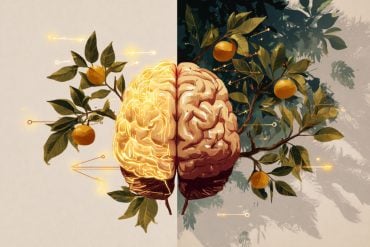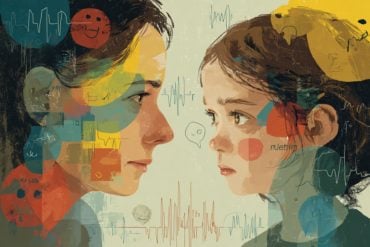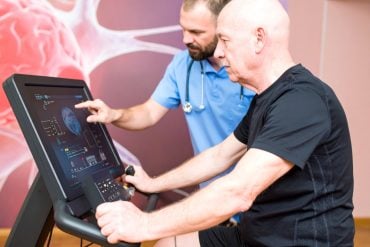Summary: Listening to music synchronizes heart rates within individuals more reliably than between different people. This synchronization depends on physiological responses rather than mood or music preferences.
The findings help explain the collective emotional experiences of audiences and suggest ways to enhance theater performances. The research offers valuable clues for improving the performing arts.
Key Facts:
- Music-induced heart rate synchronization is more reliable within individuals than between different people.
- The synchronization depends on consistent physiological responses, not mood or music preferences.
- This research can enhance understanding and improve collective experiences in performing arts.
Source: Waseda University
Common input synchronization is a process where systems or organisms exposed to an identical input respond similarly. People listening to a concert, for example, could experience a synchronization of their emotions.
“Music-induced synchronization of heart rate may be the mechanism underlying the coherent behavior of a large audience in a theater,” suggests Ryota Nomura, an Associate Professor affiliated with Waseda University, Japan, while describing the mechanism.
Previous studies have shown that inter-subject correlations calculated using physiological signals, including heart rate, are usually low.
Studies investigating the common-input induced synchronization in different individuals suggest that the low correlation is due to weak intra-person correlation between the conscious processing and heart rate. This intra-person correlation is challenging to control directly.
Hence, the current study by Dr. Nomura eliminated the individual differences in the processing by applying common input to the same individuals repeatedly.
Dr. Nomura has recently published this insightful study in Scientific Reports on 28 May 2024. In the study, Dr. Nomura showed that the synchronization of physical and cognitive processes is better within an individual compared to that between different individuals.
The study revealed that the heart rate synchronization in response to music depends on the reliable physiological responses of the listener, not on their mood or music preferences.
“This study allows us to explain the reproducibility of the aesthetic experience of the theater in terms of reliability,” notes Dr. Nomura.
The study investigated the inter- and intra-subject correlations calculated using instantaneous heart rate data measured while listening to music. To estimate the effect of mood on music-induced heart rate synchronization, Dr. Nomura had participants in the study listen to the same piece of music on different days.
Likewise, to quantify the influence of music preference on heart rate synchronization, he investigated whether a person listening to a piece of music selected by the researcher differed in synchronization response to a piece of music that deeply moves them when played in a randomized order.
Dr. Nomura discovered that the reliability with which a subject’s heart rate responded to the music is significantly more correlated across time for a given individual, compared to the inter-subjective correlation in responses between individuals.
“The results demonstrated that inter-subject correlations were consistently lower compared to intra-subject correlations, regardless of participants’ music preferences and daily moods. Further, music-induced heart rate synchronization depends on the reliability of physiological responses to musical pieces rather than mood or motivation,” Dr. Nomura observes.
Overall, the study will lead to a greater understanding of collective human emotion as a way to improve the theater-going experience. By discovering what factors contribute to heart-rate synchronization and consequent emotional response, this study offers valuable clues for the success of performing arts.
“From data on small audiences, for example, the degree of proficiency of performers, commercial success can be predicted in terms of reliability.
“This could contribute to better performances in theaters. Moreover, engineered devices that enhance reliability may facilitate synchronization of the physiological states of multiple audience members,” concludes Dr. Nomura, while highlighting the implications of the study.
About this music, emotion, and neuroscience research news
Author: Armand Aponte
Source: Waseda University
Contact: Armand Aponte – Waseda University
Image: The image is credited to Neuroscience News
Original Research: Open access.
“Reliability for music‑induced heart rate synchronization” by Ryota Nomura et al. Scientific Reports
Abstract
Reliability for music‑induced heart rate synchronization
Common inputs synchronize various biological systems, including human physical and cognitive processes. This mechanism potentially explains collective human emotions in theater as unintentional behavioral synchronization.
However, the inter-subject correlation of physiological signals among individuals is small.
Based on findings on the common-input synchronization of nonlinear systems, we hypothesized that individual differences in perceptual and cognitive systems reduce the reliability of physiological responses to aesthetic stimuli and, thus, disturb synchronization.
We tested this by comparing the inter- and intra-subject Pearson’s correlation coefficients and nonlinear phase synchronization, calculated using instantaneous heart rate data measured while appreciating music.
The results demonstrated that inter-subject correlations were consistently lower than intra-subject correlations, regardless of participants’ music preferences and daily moods.
Further, music-induced heart rate synchronization depends on the reliability of physiological responses to musical pieces rather than mood or motivation.
This study lays the foundation for future empirical research on collective emotions in theater.







